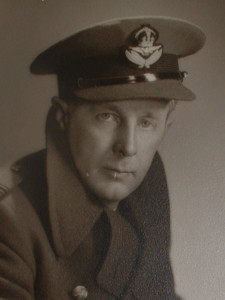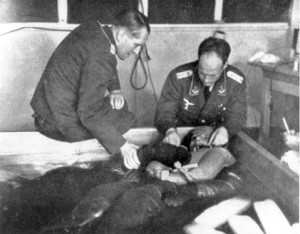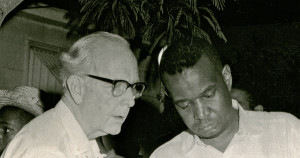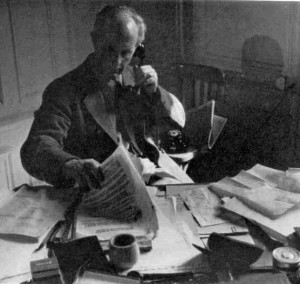In 1945 Dr. John W. Thompson could not have anticipated the horrors of Bergen Belsen, and he had no time to recover. Immediately after treating survivors of the camp as an Allied doctor, he was ordered to investigate Nazi medical research. He never fully recovered from these traumas, yet what he would go on to accomplish was extraordinary. Although largely unknown today, John W. Thompson made some of the greatest contributions to medical ethics since Hippocrates. He was the driving force behind the Nuremberg Doctors’ Trial and the father of the Nuremberg Code presented at the end of the Trial.(1)
Thompson’s multi-national background must have helped him achieve all that he did.(2) Born in Mexico in 1906, one of six children of an American electrical engineer and a Mexican/Scottish mother, John Thompson was sent to live with Scottish relatives in California for middle and high school. He went on to Stanford University and received a medical degree from the University of Edinburgh in Scotland. After a clinical appointment in psychiatry in Edinburgh, he assumed research positions at Harvard and Massachusetts General Hospital. He was a gifted clinician, but had there been no war, he probably would have been known best for his research. At Mass General, he studied the physiological basis of emotions and the respiration patterns of schizophrenic patients. At Harvard, he studied physiological and emotional factors of good social adjustment. John F. Kennedy was one of the participants in his Harvard research.
In 1940 he moved to Canada to support the scientific war effort. He applied his work on physiology of emotions and breathing patterns under stress to the study of pilot fear responses and decompression sickness. He was given a commission in the Royal Canadian Air Force and assigned to screen airmen. Thompson’s research on the performance and safety of pilots came to the attention of the British. In January, 1944, he became Medical Liaison Officer of the Joint Services Medical Intelligence Organization and prepared to accompany invasion forces in Europe.
In March 1945 he completed a course in German military organization and allied plans for post-war Germany, but this could not have prepared him for what he found weeks later when he entered Bergen-Belsen. For several months he treated concentration camp survivors under horrific conditions. Soon after this, he followed his assignment to investigate German wartime aviation research as chief of the scientific and technical branch of the British scientific intelligence agency.
Thompson and his team traveled widely over post-war Germany, examining medical records, interviewing doctors, investigating research programs. Initially, the objective was to identify scientific discoveries of potential value to the allied countries. But Thompson soon began to divide their findings into legitimate medical research and unethical forms of research and medical practice. Their schedule was intense and exhausting. In one three month period his team collected over 2,200 documents on what he called “medical war crimes.”
The research expertise of the team was critical for the credibility of their investigations. Thompson was particularly knowledgeable about pilot endurance. One could only imagine his shock at the experiments ordered by Heinrich Himmler on methods of treating hypothermia in downed German pilots. Prisoners from Dachau were forced to lie in tanks filled with ice until they were unconscious and near death, as the Nazi doctors meticulously recorded their behavioral and physiological reactions.(3) Then the doctors tested various ways to revive the research subjects. In the method named “animal warmth,” animals or nude women prisoners were forced to lie close to the frozen men to “rewarm” them. A high failure rate added to the horrors of this scenario. Documents on Nazi research atrocities are very difficult to read. That Thompson studied thousands of them in a short period of time is incredible.
Thompson soon discovered that the camp experiments were only part of the medical atrocities perpetrated throughout Nazi Germany. In December, 1945, he informed the British War Crimes Executive at Nuremberg that a large number of doctors at the highest level of the German medical profession were involved in unethical research. Cadavers and tissue samples from camp prisoners were used in studies at universities and hospitals far from the camps.
During this period Thompson combined his research expertise with skillful networking among the allied powers. He reported the medical war crimes to the U.S. State Department and the British Foreign Office and organized conferences with allied leaders to discuss the implications. He was building allied support for holding the doctors accountable. Confronted with tomes of evidence implicating many German doctors, the Nuremberg executives chose to limit prosecution to those most responsible for the euthanasia programs and inhuman medical experimentation.
Thompson was convinced that medical atrocities would happen again elsewhere. In the summer of 1946, before the Nuremberg Doctors’ Trial, he organized a conference at the Pasteur Institute in France on medical war crimes, the importance of informed consent, and ways to protect human research subjects. He conferred in particular with representatives of the American Medical Association, convinced that the support of medical associations was essential to hold doctors accountable in the future. He was laying the groundwork for the Nuremberg Code for protection of human research subjects.
Thompson was an observer at the Doctors’ Trial and consulted often with the American medical experts giving testimony. After the 7-month trial and before sentencing, he interviewed many of the convicted Nuremberg doctors for insight into their motivations and behavior. As Chief Prosecutor Telford Taylor asserted, the world needed to know why doctors who had sworn to “do no harm” had treated people as less than beasts.(4) Sixteen of the 23 defendants were found guilty of crimes against humanity. Seven of these were sentenced to death by hanging, including doctors involved in the freezing experiments. Nine others received sentences of from 10 years to life imprisonment.
The Nuremberg judges did not stop at prosecuting the doctors. They articulated rules for human experimentation to help prevent medical war crimes in the future. The American Medical Association had approved three principles for ethical medical research in time for the Doctors’ Trial. The judges expanded this list to ten and shifted the AMA emphasis on the duties of the research doctor to a ringing assertion of the human rights and authority of the research subject.(5) The Nuremberg Code echoes today throughout many codes of patients rights and ethical medical practice and research.
 Shortly before the war, Thompson had converted to Catholicism, strongly influenced by liberal philosophers such as Jacques Maritain. In the 1950s he lived at Au Vive, a Catholic religious/educational retreat near Paris that he helped to develop. Eau Vive became an open community of scholars, patients, clergy, and students, including briefly, Angelo Roncalli, who would become Pope John the 23rd. Thompson himself adhered to a very ecumenical form of Catholicism. He was widely read, and steeped especially in the works of Judaic scholars and writers like Martin Buber. After the war, Thompson worked for UNESCO in Germany and his network of friends and colleagues reads like a Who’s Who of political leaders, scholars, and educators concerned with post-war recovery, among them German Chancellor Conrad Adenauer, T.S. Eliot and Maria Montesorri.
Shortly before the war, Thompson had converted to Catholicism, strongly influenced by liberal philosophers such as Jacques Maritain. In the 1950s he lived at Au Vive, a Catholic religious/educational retreat near Paris that he helped to develop. Eau Vive became an open community of scholars, patients, clergy, and students, including briefly, Angelo Roncalli, who would become Pope John the 23rd. Thompson himself adhered to a very ecumenical form of Catholicism. He was widely read, and steeped especially in the works of Judaic scholars and writers like Martin Buber. After the war, Thompson worked for UNESCO in Germany and his network of friends and colleagues reads like a Who’s Who of political leaders, scholars, and educators concerned with post-war recovery, among them German Chancellor Conrad Adenauer, T.S. Eliot and Maria Montesorri.
In 1959, a friend from his Harvard days persuaded him to move to New York and train psychiatric residents at Albert Einstein College of Medicine. At Einstein and Bronx Psychiatric Hospital where the residents trained, he was admired for his ability to relate to very disturbed patients. In New York Thompson continued to write on the Holocaust and worked to overcome the impediments to compensating its victims. He used his connections to Willy Brandt, leader of the West German Social Democratic Party, to press for automatic compensation for those who were in the camps longer than six months.(6)
“…there is an irony that we ask for data to convince us that someone who has been brutalized, mauled, tortured, humiliated, spat upon, mercilessly thrown into the pit of death yet kept alive only to be tortured more by ever deepening wounds…we ask for data to convince us that such a one has been permanently damaged….[mankind is] drowning today in a sea of data and dying of thirst in a moral desert.”(7)
John W. Thompson
Presentation at Forum on Late Consequences of Massive Traumatization, New York 1965
For several years Thompson led a “Provisional Committee for the Victims of Human Disasters,” hoping to establish an international organization for the rehabilitation of survivors. He did not live to see the worldwide network of programs for the treatment of torture survivors that took root in the early 1970s.(8) He died in 1965 at the age of 59, from an accident while on vacation in the Caribbean. He was so highly esteemed by the colleagues who worked with him in New York that a Bronx Psychiatric Hospital building is named after him.
Despite Thompson’s accomplishments and his long list of prominent friends and colleagues, he all but disappeared from the history books. Decades after Thompson’s death, a British bioethicist, Paul J. Weindling, was examining original documents on Nazi medicine and was surprised to find that a doctor had led an international conference on informed consent of research subjects months before the Nuremberg Doctors Trial. His curiosity about this doctor led to years of research and many interviews of Thompson’s family, friends and colleagues. He completed a biography of John W.Thompson, Psychiatrist in the Shadow of the Holocaust in 2010.
A Personal Remembrance
I was fortunate to meet Dr. Thompson in 1964.(9) He had volunteered with the Medical Committee for Human Rights (MCHR), an organization of health care professionals supporting the massive voting rights project in Mississippi that summer. I was working with other Freedom Summer volunteers, and Dr. Thompson and I happened to be assigned to the same town, Clarksdale, Mississippi.
I remember him distinctly. Although quiet and reserved, he had a powerful handshake and connected immediately with the civil rights workers and the local people. We met again in New York at a gathering of MCHR supporters and he was eager to talk with a fellow “veteran” from Mississippi. The difference in our age and professional status seemed to matter not at all to him. As we talked, he recalled his time in Bergen Belsen. He described how the oldest and sickest women were slow to be moved out, so he dummied some Air Force orders and got a large group of them flown to Paris where he cared for them in temporary accommodations. I believe some of these women came to live at Eau Vive. Thompson said the retreat was run intentionally as the very opposite of a concentration camp: everyone welcome, no last names needed, no strict rules, shared administration.(10) He talked about Eau Vive as if he still missed it.
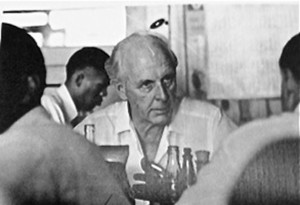
1965 photos by Frazer Thomason, Hazelton Freedom Summer Collection, McCain Library and Archives, The University of Southern Mississippi
In Mississippi it was understood that the people risking their lives to get the vote would get the safety of press coverage and national attention if they were joined by students and professionals from around the country. It was the custom at the community meetings in the Clarksdale church to introduce the health professionals, lawyers, and clergy who visited. I can still remember the dignified, white-haired doctor introduced at one meeting. With a deep, resonant voice, Dr. Thompson said, “Thank you. It is an honor to be here with you. I just want to say that I have known people who have suffered as you are suffering and I know you will win.”
Martha Davis
Director, Expert Witness and Doctors of the Dark Side
Update: The lessons of Nazi medicine are so important today that there
is an organization devoted to their application.
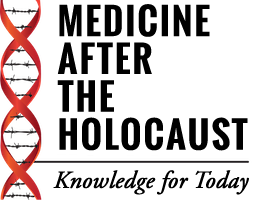 The mission of the Center for Medicine after the Holocaust (CMATH) is to challenge doctors, nurses, and bioscientists to personally confront the medical ethics of the Holocaust and to apply that knowledge to contemporary practice and research. It does this by identifying “Champions” at medical centers around the world who study, teach, and research medicine and the Holocaust, by providing resources such as curricula, videos, books for them, by convening local, national and international conferences on medicine after the Holocaust, and by hosting a biennial trip to European medical sites relevant to the Holocaust. For more information:
The mission of the Center for Medicine after the Holocaust (CMATH) is to challenge doctors, nurses, and bioscientists to personally confront the medical ethics of the Holocaust and to apply that knowledge to contemporary practice and research. It does this by identifying “Champions” at medical centers around the world who study, teach, and research medicine and the Holocaust, by providing resources such as curricula, videos, books for them, by convening local, national and international conferences on medicine after the Holocaust, and by hosting a biennial trip to European medical sites relevant to the Holocaust. For more information:
www.medicineaftertheholocaust.org
- Authorship of some entries in the Code is justly credited to Drs. Andrew Ivy and Leo Alexander who testified at the Nuremberg Doctors’ Trial and to the American judges who expanded their recommendations to ten principles.
See Evelyne Shuster, Fifty Years Later: The Significance of the Nuremberg Code, NEJM, 337: 1436-1440,1997 http:// www.nejm.org/doi/full/10.1056/NEJM199711133372006 However, Thompson’s biographer presents extensive evidence of his role in the Code’s development. Six months before the trial, Thompson organized a conference on medical war crimes at the Pasteur Institute in Paris and opened it with a speech on informed consent and the rights of the patient. Dr. Ivy attended that conference and Thompson urged him to focus on accountability. Thompson knew Ivy from before the war, and Alexander and Thompson were research colleagues in the mid-1930s. Thompson conferred extensively with Ivy, Alexander and tribunal lawyers at the Doctors’ Trial. - I am indebted to Professor Weindling and his fascinating biography for most of the information on Thompson’s history. John W. Thompson: Psychiatrist in the Shadow of the Holocaust by Paul. J. Weindling (University of Rochester Press, 2010)
- “The defensive movements ceased after about five minutes. There followed a progressive rigor, which developed especially strongly in the arm musculature; the arms were strongly flexed and pressed to the body. The rigor increased with the continuation of the cooling, now and then interrupted by tonic-clonic twitchings. With still more marked sinking of the body temperature, it suddenly ceased. These cases ended fatally, without any successful results from resuscitation efforts.” Harvard Law Library Nuremberg Trials Project: Doctors Trial, NMT Case 1, U.S.A. v. Karl Brandt et al. Excerpt of Medical Transcript, p. 29, Dec. 9, 1946. http://nuremberg.law.harvard.edu/php/docs_swi.php?DI=1&text=medical
- Shuster, NEJM, 1997.
- Shuster, NEJM, 1997.
- Weindling, p. 309.
- Quoted in Weindling, p. 311.
- International Rehabilitation Council for Torture Victims has over 140 member rehabilitation centers today.
- In 1964 I worked as a research assistant at Albert Einstein before going on to psychology graduate school, and I had heard about Dr. Thompson from colleagues there. He was known as the doctor who had treated holocaust survivors and was extraordinarily helpful to very disturbed psychiatric patients. I did not know he was the father of the Nuremberg Trials and the Nuremberg Code until 2014 while working on Expert Witness.
- In 1964, Dr. Thompson’s stories were so unusual, I wondered how they could be true, but I found many of them confirmed in his biography. His life was filled with amazing experiences and extraordinary friends and colleagues.
Authorship of some entries in the Code is justly credited to Drs. Andrew Ivy and Leo Alexander who testified at the Nuremberg Doctors’ Trial and to the American judges who expanded their recommendations to ten principles.
See Evelyne Shuster, Fifty Years Later: The Significance of the Nuremberg Code, NEJM, 337: 1436-1440,1997 http:// www.nejm.org/doi/full/10.1056/NEJM199711133372006 However, Thompson’s biographer presents extensive evidence of his role in the Code’s development. Six months before the trial, Thompson organized a conference on medical war crimes at the Pasteur Institute in Paris and opened it with a speech on informed consent and the rights of the patient. Dr. Ivy attended that conference and Thompson urged him to focus on accountability. Thompson knew Ivy from before the war, and Alexander and Thompson were research colleagues in the mid-1930s. Thompson conferred extensively with Ivy, Alexander and tribunal lawyers at the Doctors’ Trial.
I am indebted to Professor Weindling and his fascinating biography for most of the information on Thompson’s history. John W. Thompson: Psychiatrist in the Shadow of the Holocaust by Paul. J. Weindling (University of Rochester Press, 2010)
“The defensive movements ceased after about five minutes. There followed a progressive rigor, which developed especially strongly in the arm musculature; the arms were strongly flexed and pressed to the body. The rigor increased with the continuation of the cooling, now and then interrupted by tonic-clonic twitchings. With still more marked sinking of the body temperature, it suddenly ceased. These cases ended fatally, without any successful results from resuscitation efforts.” Harvard Law Library Nuremberg Trials Project: Doctors Trial, NMT Case 1, U.S.A. v. Karl Brandt et al. Excerpt of Medical Transcript, p. 29, Dec. 9, 1946. http://nuremberg.law.harvard.edu/php/docs_swi.php?DI=1&text=medical
Shuster, NEJM, 1997.
Shuster, NEJM, 1997.
Weindling, p. 309.
Quoted in Weindling, p. 311.
International Rehabilitation Council for Torture Victims has over 140 member rehabilitation centers today.
In 1964 I worked as a research assistant at Albert Einstein before going on to psychology graduate school, and I had heard about Dr. Thompson from colleagues there. He was known as the doctor who had treated holocaust survivors and who was extraordinarily helpful to very disturbed psychiatric patients. I did not know he was the father of the Nuremberg Trials and the Nuremberg Code until 2014 while working on Expert Witness.
In 1964, Dr. Thompson’s stories were so unusual, I wondered how they could be true, but I found many confirmed in his biography. His life was filled with amazing experiences and extraordinary friends and colleagues.
